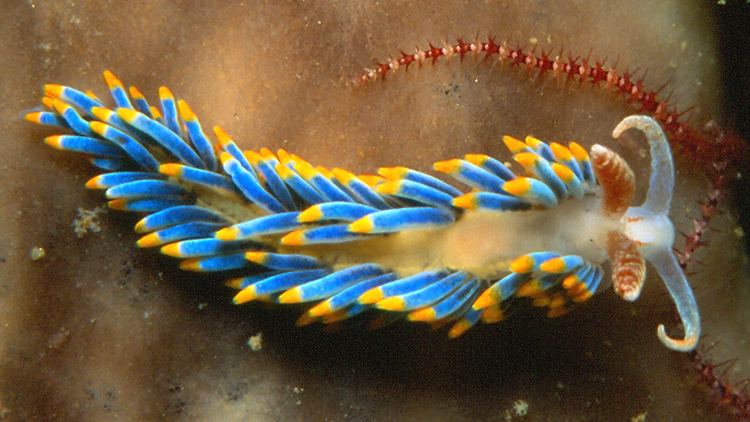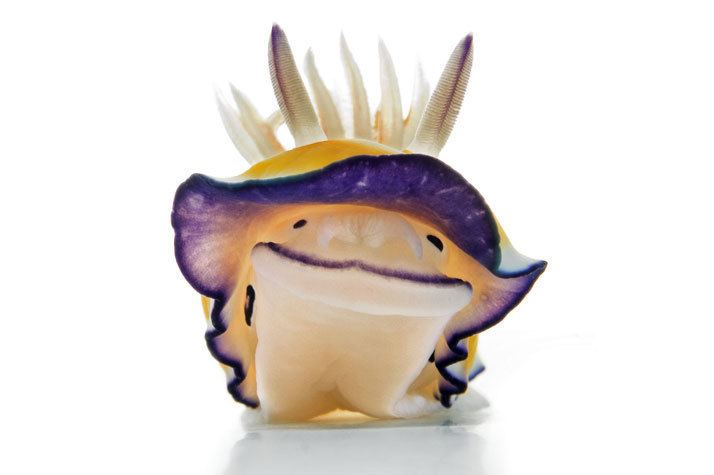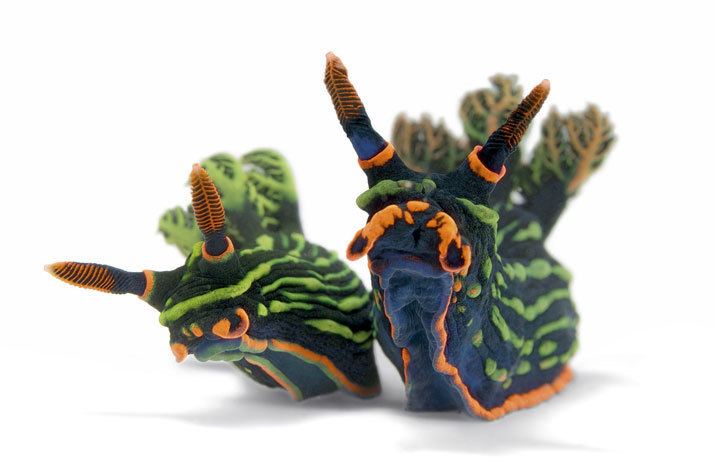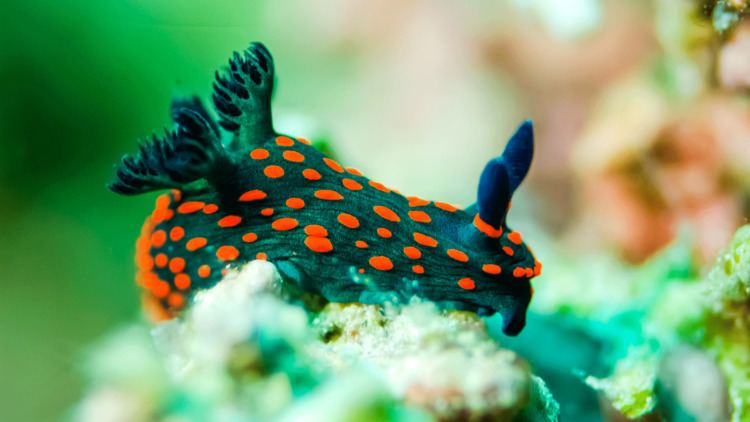Kingdom Animalia Higher classification Gastropods | Scientific name Nudibranchia Phylum Mollusca | |
 | ||
Lower classifications Chromodoris, Glaucus, Flabellina, Melibe, Nembrotha Similar Glaucus (gastropod), Berghia, Dorididae | ||
Nudibranchs jonathan bird s blue world extra
Nudibranchs /ˈnjuːdᵻbræŋk/ are a group of soft-bodied, marine gastropod molluscs which shed their shells after their larval stage. They are noted for their often extraordinary colours and striking forms. Currently, about 2,300 valid species of nudibranchs are known.
Contents
- Nudibranchs jonathan bird s blue world extra
- 50 shades of nudibranch
- Distribution and habitat
- Anatomical description
- Defense mechanisms
- Apparent production of sound
- Lifecycle
- Feeding and ecological role
- Taxonomy
- Traditional hierarchy
- Early revisions
- Gallery
- References

The word "nudibranch" comes from the Latin nudus, naked, and the Greek βραγχια, brankhia, gills.
Nudibranchs are often casually called sea slugs, but many sea slugs belong to several taxonomic groups which are not closely related to nudibranchs. A number of these other sea slugs, such as the photosynthetic Sacoglossa and the colourful Aglajidae, are often confused with nudibranchs.

50 shades of nudibranch
Distribution and habitat
Nudibranchs occur in seas worldwide, including in the tropics and the Southern Ocean.

Nudibranchs live at virtually all depths of salt water, from the intertidal zone to depths well over 700 m (2,300 ft). The greatest diversity of nudibranchs is seen in warm, shallow reefs, although a new nudibranch species was discovered at a depth near 2,500 m (8,200 ft).

Nudibranchs are benthic animals, found crawling over the substrate. The only exceptions to this are the neustonic Glaucus nudibranchs, which float upside down just under the ocean's surface, and the pelagic nudibranchCephalopyge trematoides, which swims in the water column.
Anatomical description

The body forms of nudibranchs vary a great deal, but because they are opisthobranchs, unlike most other gastropods, they are apparently bilaterally symmetrical externally (but not internally) because they have undergone secondary detorsion. In all nudibranchs, the male and female sexual openings are on the right side of the body, reflecting their asymmetrical origins. They lack a mantle cavity. Some species have venomous appendages (cerata) on their sides, which deter predators. Many also have a simple gut and a mouth with a radula.

The eyes in nudibranchs are simple and able to discern little more than light and dark. The eyes are set into the body, are about a quarter of a millimeter in diameter, and consist of a lens and five photoreceptors.
Nudibranchs vary in adult size from 4 to 600 mm (0.16 to 23.62 in).
The adult form is without a shell or operculum (in shelled gastropods, the operculum is a bony or horny plate that can cover the opening of the shell when the body is withdrawn). In most species is a swimming veliger larva with a coiled shell which is shed at metamorphosis when the larva transforms into the adult form. Some species have direct development and the shell is shed before the animal emerges from the egg mass.
The name nudibranch is appropriate, since the dorids (infraclass Anthobranchia) breathe through a "naked gill" shaped into branchial plumes in a rosette on their backs. By contrast, on the back of the aeolids in the clade Cladobranchia there are brightly coloured sets of protruding organs called cerata.
Nudibranchs have cephalic (head) tentacles, which are sensitive to touch, taste, and smell. Club-shaped rhinophores detect odors.
Defense mechanisms
This group includes some of the most colourful creatures on earth. In the course of their evolution, nudibranchs have lost their shell while developing alternative defense mechanisms. Some species evolved an external anatomy with textures and colors that mimicked surrounding sessile invertebrate animals (often their prey sponges or soft corals) to avoid predators (see camouflage). Other nudibranchs, as seen especially well on chromodorids, have an intensely bright and contrasting color pattern that makes them especially conspicuous in their surroundings. Nudibranch molluscs are the most commonly cited examples of aposematism in marine ecosystems, but the evidence for this has been contested, mostly because few examples of mimicry are seen among species, many species are nocturnal or cryptic, and bright colors at the red end of the spectrum are rapidly attenuated as a function of water depth. For example, the Spanish dancer nudibranch (genus Hexabranchus), among the largest of tropical marine slugs, potently chemically defended, and brilliantly red and white, is nocturnal and has no known mimics. Other studies of nudibranch molluscs have concluded they are aposematically colored, for example, the slugs of the family Phylidiidae from Indo-Pacific coral reefs.
Nudibranchs that feed on hydrozoids can store the hydrozoids' nematocysts (stinging cells) in the dorsal body wall, the cerata. These stolen nematocysts, called kleptocnidae, wander through the alimentary tract without harming the nudibranch. Once further into the organ, the cells are assimilated by intestinal protuberances and brought to specific placements on the creature's hind body. Nudibranchs can protect themselves from the hydrozoids and their nematocysts; the specific mechanism is yet unknown, but special cells with large vacuoles probably play an important role. Similarly, some nudibranchs can also take in plant cells (symbiotic algae from soft corals) and reuse these to make food for themselves. The related group of sacoglossan sea slugs feed on algae and retain just the chloroplasts for their own photosynthetic use, a process known as kleptoplasty.
Nudibranchs use a variety of chemical defenses to aid in protection, but it is not necessary for the strategy to be lethal to be effective; in fact, good arguments exist that chemical defenses should evolve to be distasteful rather than toxic. Some sponge-eating nudibranchs concentrate the chemical defences from their prey sponge in their bodies, rendering themselves distasteful to predators. The evidence that suggests the chemical compounds used by dorid nudibranchs do in fact come from dietary sponges lies in the similarities between the metabolites of prey and nudibranchs, respectively. Furthermore, nudibranchs contain a mixture of sponge chemicals when they are in the presence of multiple food sources, as well as change defense chemicals with a concurrent change in diet. This, however, is not the only way for nudibranchs to develop chemical defenses. Certain species are able to produce their own chemicals de novo without dietary influence. Evidence for the different methods of chemical production comes with the characteristic uniformity of chemical composition across drastically different environments and geographic locations found throughout de novo production species compared to the wide variety of dietary and environmentally dependent chemical composition in sequestering species.
Another method of protection is the release of an acid from the skin. Once the specimen is physically irritated or touched by another creature, it will release the mucus automatically.
Apparent production of sound
In 1884, Philip Henry Gosse reported observations by "Professor Grant" (possibly Robert Edmond Grant) that two species of nudibranchs emit sounds that are audible to humans.
"Two very elegant species of Sea-slug, viz., Eolis punctata [i.e. Facelina annulicornis], and Tritonia arborescens [i.e. Dendronotus frondosus], certainly produce audible sounds. Professor Grant, who first observed the interesting fact in some specimens of the latter which he was keeping in an aquarium, says of the sounds, that 'they resemble very much the clink of a steel wire on the side of the jar, one stroke only been given at a time, and repeated at intervals of a minute or two; when placed in a large basin of water the sound is much obscured, and is like that of a watch, one stroke being repeated, as before, at intervals. The sound is longest and most often repeated when the Tritonia are lively and moving about, and is not heard when they are cold and without any motion; in the dark I have not observed any light emitted at the time of the stroke; no globule of air escapes to the surface of the water, nor is any ripple produced on the surface at the instant of the stroke; the sound, when in a glass vessel, is mellow and distinct.' The Professor has kept these Tritonia alive in his room for a month, and during the whole period of their confinement they have continued to produce the sounds with very little diminution of their original intensity. In a small apartment they are audible at the distance of twelve feet. The sounds obviously proceed from the mouth of the animal; and at the instant of the stroke, we observe the lips suddenly separate, as if to allow the water to rush into a small vacuum formed within. As these animals are hermaphrodites, requiring mutual impregnation, the sounds may possibly be a means of communication between them, or, if they are of an electric nature, they may be the means of defending from foreign enemies one of the most delicate, defenceless, and beautiful Gasteropods that inhabit the deep."
Lifecycle
Nudibranchs are hermaphroditic, thus have a set of reproductive organs for both sexes, but they cannot fertilize themselves. Nudibranchs typically deposit their eggs within a gelatinous spiral.
Feeding and ecological role
All known nudibranchs are carnivorous. Some feed on sponges, others on hydroids,(e.g. Cuthona) others on bryozoans (phanerobranchs such as Tambja, Limacia, Plocamopherus and Triopha), and some eat other sea slugs or their eggs (e.g. Favorinus) or, on some occasions, are cannibals and prey on members of their own species. Other groups feed on tunicates (e.g. Nembrotha, Goniodoris), other nudibranchs (Roboastra, which are descended from tunicate-feeding species), barnacles (e.g. Onchidoris bilamellata), and anemones (e.g. the Aeolidiidae and other Cladobranchia).
The surface-dwelling nudibranch, Glaucus atlanticus, is a specialist predator of siphonophores, such as the Portuguese man o' war. This predatory mollusc sucks air into its stomach to keep it afloat, and using its muscular foot, it clings to the surface film. If it finds a small victim, Glaucus simply envelops it with its capacious mouth, but if the prey is a larger siphonophore, the mollusc nibbles off its fishing tentacles, the ones carrying the most potent nematocysts. Like some others of its kind, Glaucus does not digest the nematocysts; instead, it uses them to defend itself by passing them from its gut to the surface of its skin.
Taxonomy
Nudibranchs are commonly divided into two main kinds, dorid and aeolid (also spelled eolid) nudibranchs:
The exact systematics of nudibranchs are a topic of recent revision. Traditionally, nudibranchs have been treated as the order Nudibranchia, located in the gastropod mollusc subclass Opisthobranchia (the marine slugs: which consisted of nudibranchs, sidegill slugs, bubble snails, algae sap-sucking sea slugs, and sea hares). Since 2005, pleurobranchs (which had previously been grouped among sidegill slugs) have been placed alongside nudibranchs in the clade Nudipleura (recognising them as more closely related to each other than to other opisthobranchs). Since 2010, Opisthobranchia has been recognised as not a valid clade (it is paraphyletic) and instead Nudipleura has been placed as the first offshoot of Euthyneura (which is the dominant clade of gastropods).
Traditional hierarchy
This classification was based on the work of Johannes Thiele (1931), who built on the concepts of Henri Milne-Edwards (1848).
Order Nudibranchia:
Early revisions
Newer insights derived from morphological data and gene-sequence research seemed to confirm those ideas. On the basis of investigation of 18S rDNA sequence data, strong evidence supports the monophyly of the Nudibranchia and its two major groups, the Anthobranchia/Doridoidea and Cladobranchia. A study published in May 2001, again revised the taxonomy of the Nudibranchia. They were thus divided into two major clades:
However, according to the taxonomy by Bouchet & Rocroi (2005), currently the most up-to-date system of classifying the gastropods, the Nudibranchia are a subclade within the clade of the Nudipleura. The Nudibranchia are then divided into two clades:
Gallery
This gallery shows some of the great variability in the color and form of nudibranchs, and nudibranch egg ribbons.
